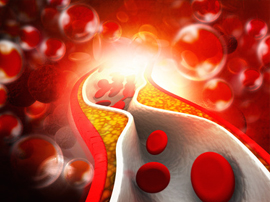The human body manufactures cholesterol to help build healthy cells. However, too much cholesterol in your blood forms fatty deposits that can narrow arteries, impeding blood flow and causing your heart to work too hard.
These fatty deposits, called plaque, also can become inflamed and rupture, leading to a heart attack or stroke.
Your doctor should administer a blood lipid profile, which will provide three important numbers.
The first is your low-density cholesterol (LDL), which is also called “bad” cholesterol because it is the type that builds up in your coronary arteries.
The second is high-density cholesterol (HDL), which is the “good” cholesterol that helps lower the level of the LDL cholesterol.
The third, all-important number is your total cholesterol — which is simply the sum of both.
While total cholesterol is the most important factor, you should also make sure that the lipid profile provides advanced information on how your cholesterol is comprised.
LDL cholesterol is made up of two different types of particles: Pattern A and Pattern B.
Pattern A cholesterol particles are large and fluffy; they bounce off your arterial walls. Pattern B particles are more dangerous — they are small and compact, and can embed in the arterial walls, causing damage.
Pattern B LDL particles are the ones that create dangerous plaque. Taking 500 to 2,500 mg of vitamin B3 (niacin) daily can help change dangerous Pattern B particles to the less harmful Pattern A.
Current guidelines maintain that having a total cholesterol level of 200 mg/dL is desirable. These guidelines are far too lax. For my patients, the goal is a cholesterol level of less than 150 mg/dL.
If you have high cholesterol, you may initially need to take a statin drug to lower your number.
However, by changing to a plant-based diet, you can ultimately maintain these levels without drugs. This will not only prevent heart disease, but can even reverse it if you already have the diagnosis.
When it comes to lowering cholesterol, the focus tends to be on what you shouldn’t eat, rather than what you should. But new research published in the Journal of the American Medical Association indicates that this may not be the best approach.
The study showed that people who incorporated cholesterol-lowering foods such as oats, barley, soy milk, tofu, nuts, and legumes reduced their cholesterol reading by an average of 14 points.
Meanwhile, a control group — which followed a standard, low-fat diet — showed only a 3 percent decline in cholesterol.
Fourteen points could make the difference between needing a statin drug and not needing one.
For a great cholesterol-lowering dessert, slice up some firm tofu, sprinkle with walnuts and slightly drizzle with maple syrup. You’ll get two potent, cholesterol-lowering foods in one great-tasting treat!

